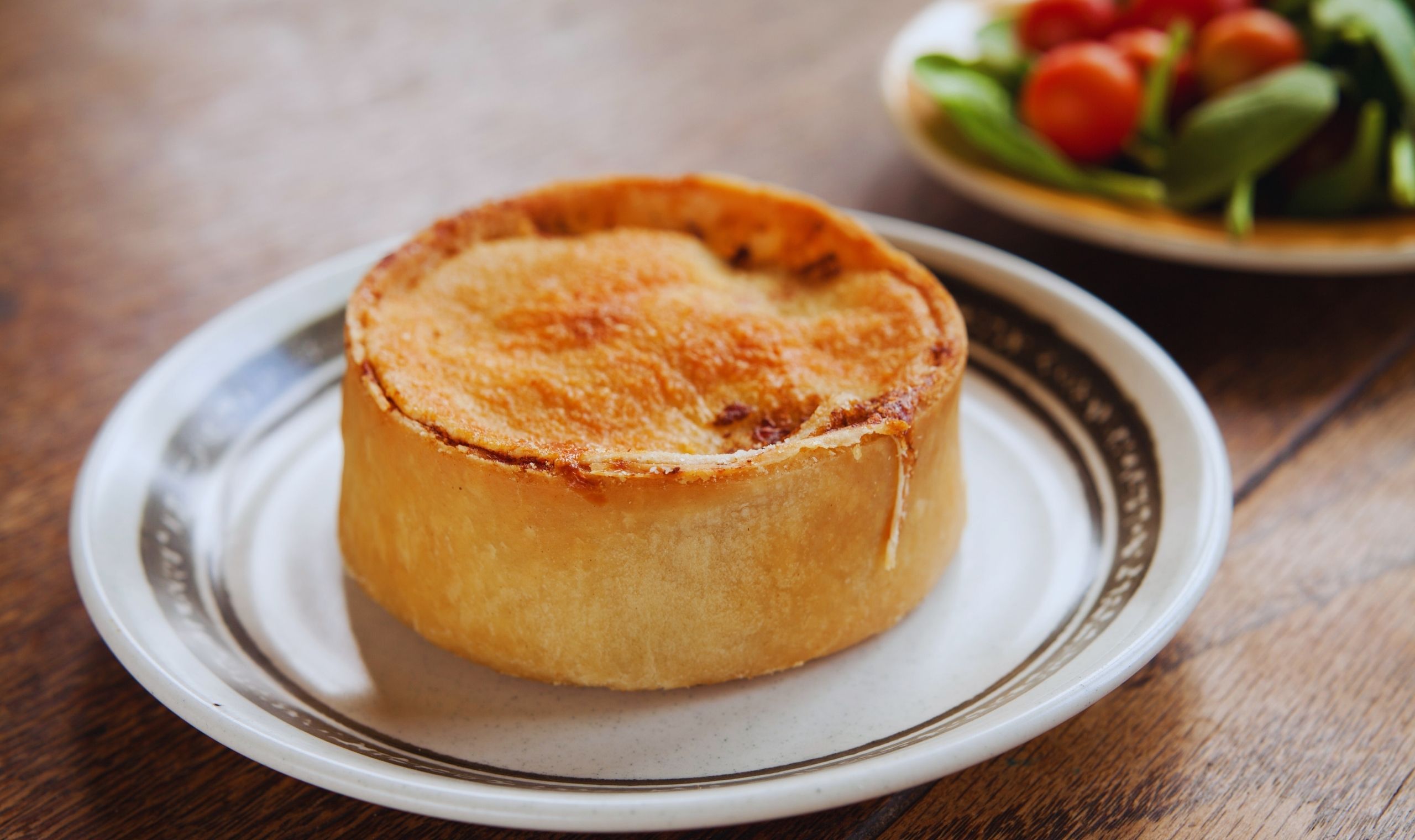The Delicious Journey of Scotch Pie: History, Recipes, and More
The Scotch pie is a cherished element of Scottish cuisine, with its origins deeply rooted in Scotland’s culinary tradition. Initially, this hearty meat pie started as a simple dish, primarily featuring minced lamb or mutton encased in a crisp, double-crust pastry. It is believed that Scotch pies have been enjoyed since the 18th century, when they were often prepared by local bakers and consumed by laborers due to their portability and satisfying nature. Over the years, the pie evolved beyond its simple beginnings, leading to various adaptations and regional specialties.
As different areas of Scotland sought to put their unique spin on the Scotch pie, variations began to emerge. For instance, some regions incorporated game meats or beef into the filling, while others introduced spices and herbs to enhance flavor. The influence of local ingredients contributed to the diversification of the pie, resulting in unique interpretations across the Scottish landscape. The adaptability of the Scotch pie speaks to its significance in Scottish culture, as it continues to reflect both historical practices and contemporary culinary trends.
In addition to its delicious taste, the Scotch pie holds a prominent place in traditional Scottish events and celebrations. It is frequently enjoyed during sporting events, particularly at football matches, where it is seen as a quintessential snack. The pie’s association with community gatherings and festive occasions highlights its role as a culinary symbol in Scottish traditions. With its rich history and widespread popularity, the Scotch pie has undeniably cemented its status as a staple food within Scotland, embodying the essence of the nation’s gastronomy while maintaining a connection to its past.
Historical Context
The Scotch pie, a quintessential Scottish delicacy, has a rich and varied history that traces its origins back several centuries. The earliest recorded mentions date to the 18th century, approximately around the 1700s, when the pie was primarily made as a convenient, portable meal for working-class individuals. Its popularity soared due to its ability to provide nourishment while being easy to carry, a feature particularly beneficial to those engaged in labor-intensive jobs such as farming and fishing.
Throughout the years, the Scotch pie has evolved not just in preparation but also in cultural significance. Events like the Industrial Revolution contributed to its prominence, as city dwellers sought affordable and hearty meals amidst the rapid urbanization. The convenience of the Scotch pie meant that it found a place in bakeries, and it became a staple at local fairs and markets, embedding itself deeper into the fabric of Scottish life.
Moreover, the Scotch pie has been referenced in various literary sources and folklore. Notable Scottish writers, such as Robert Burns and Sir Walter Scott, have mentioned pies in their works, painting them as symbols of comfort and tradition. The pie’s robust characteristics resonate with themes of Scottish identity and heritage, emphasizing the connection between food and community. It often appears at family gatherings, celebrations, and even during traditional events like Burns Night, where it is appreciated not just for its taste but also for its cultural symbolism.
In recent times, the Scotch pie has attained recognition beyond Scotland, with various food festivals and competitions celebrating its unique qualities. Its enduring status reflects not only a delectable culinary choice but also a representation of Scottish history and the resilience of its people. Such cultural significance ensures that the Scotch pie continues to be celebrated and cherished in modern Scottish society.
The Anatomy of a Scotch Pie
The Scotch pie is a culinary delight renowned for its distinctive features. The crust of a traditional Scotch pie is made from a unique hot water pastry, which is water, flour, lard, and a pinch of salt. This pastry is notable for its exceptional texture and strength, allowing the pie to maintain its shape and hold its hearty filling, which is often crafted from mutton or lamb. Hot water pastry differs from regular pastry as it is made with hot water, which causes the fat to melt and create a more pliable dough. This feature is crucial, as it allows the pie to be robust enough to withstand baking and retain its rich flavors.
The filling of a Scotch pie primarily consists of minced lamb or mutton, combined with a blend of seasonings that typically includes black pepper, salt, and sometimes nutmeg. The peppery flavor of the filling is integral to the Scotch pie, distinguishing it from other meat pies. This signature spicing provides a subtle heat that complements the savory meat, creating a satisfying taste experience. Additionally, the richness of the lamb or mutton used contributes to the moistness and depth of flavor, making each bite incredibly fulfilling.
While the traditional Scotch pie primarily features lamb or mutton, various adaptations have emerged over the years. Some bakers may opt for beef as a filling or incorporate a medley of vegetables to cater to different dietary preferences. Conversely, some may introduce additional spices or ingredients to enhance the flavor profile. Despite these variations, the essence of the Scotch pie remains intact, rooted in its historical lineage and distinct characteristics that have captivated palates for generations.
Scotch Pie Stories
Humor often intertwines seamlessly with food, creating a delightful blend of laughter and communal experiences. Scotch pies, a beloved Scottish delicacy, are no exception to this culinary amusement. Their unique shape and scrumptious filling inspire playful jokes and puns that lighten the mood and create engaging conversations. For example, one popular joke goes, “Why did the Scotch pie go to school? Because it wanted to be a ‘smart pie’!” This lighthearted pun encapsulates the jovial spirit that food can evoke in daily life.
Food-related humor not only entertains but also serves as an important social bond. Cultural references find their place in comedic storytelling, with Scotch pies often appearing as symbols of Scottish heritage and culinary pride. Think of a classic family gathering where the Scotch pie, nestled on the table among other traditional fare, becomes the centerpiece of friendly banter. One might jest, “You call that a Scotch pie? I’ve seen larger ones at the bakery!” Such quips highlight the affection people have for this iconic dish, showcasing its stature in Scottish social settings.
Anecdotes abound, too. Picture a group of friends at a pub, half-heartedly renaming their usual drinks to include Scotch pie puns, like “Pie-tonic water” or “Bourbon and Scotch pie.” These moments of humor not only entertain but also bring people together, celebrating not only the pies but also the shared laughter and camaraderie they inspire. The delightful chaos of trying to one-up each other with the best pie-related jokes underscores the limitless creativity that food fosters. As Scotch pies continue to maintain their charm, they will undoubtedly keep inspiring jokes, puns, and an abundance of heartwarming and humorous stories for years to come.
Classic Scotch Pie Recipes
Scotch pie, a delightful pastry known for its rich filling and golden crust, can be enjoyed in various ways. Below, we explore some classic Scotch pie recipes that showcase both traditional and modern interpretations, ensuring that there’s something for everyone.
Traditional Scotch Pie
Ingredients:
- 200g minced lamb or beef
- 1 onion, finely chopped
- 1 tsp Worcestershire sauce
- Salt and pepper to taste
- 500g shortcrust pastry
- 1 egg (for egg wash)
Instructions:
- Preheat your oven to 200°C (392°F).
- In a skillet, sauté the onions until soft. Add the minced meat and cook until browned.
- Stir in Worcestershire sauce, salt, and pepper. Remove from heat and let cool.
- Roll the shortcrust pastry and cut out circles for the base and the top.
- Place a base circle in a pie tin, fill with the meat mixture, and cover with another pastry circle. Seal the edges.
- Brush the top with the egg wash and pierce a small hole in the center.
- Bake for 25–30 minutes or until golden brown.
Vegetarian Scotch Pie
For those seeking a vegetarian option, the following ingredients can be used to create a delicious alternative.
Ingredients:
- 200g lentils, cooked
- 1 carrot, grated
- 1 small courgette, grated
- 1 onion, finely chopped
- 250g puff pastry
- Salt, pepper, and herbs of choice
Instructions:
- Preheat your oven to 200°C (392°F).
- In a pan, sauté the onion until soft, then add the carrots and courgette, cooking until they soften.
- Mix in the cooked lentils, and season with salt, pepper, and desired herbs.
- Roll out the puff pastry, cutting out base and top circles.
- Fill the base with the lentil mixture, cover, and seal.
- Brush with egg wash (or milk for a vegan option) and bake for 25 minutes until golden.
These classic Scotch pie recipes highlight the versatility of this beloved dish. Feel free to experiment with flavors and ingredients to suit your palate, ensuring an authentic experience that captures the essence of Scottish cuisine.
Where to Find the Best Scotch Pies
Scotch pies are a beloved fixture of Scottish cuisine, known for their deliciously flaky crust and savory filling. When seeking out the best Scotch pies, one must look for establishments that prioritize quality ingredients and traditional baking methods. Numerous locations across Scotland boast exceptional Scotch pies, each with its own regional specialties.
One of the most renowned places for Scotch pies is the city of Edinburgh. Bakeries such as J. R. McLeod and Scottish Gourmet are famous for their handmade pies, drawing locals and tourists alike. These establishments often offer pies filled with rich minced meat, seasoned to perfection, and encased in a golden pastry that is crispy yet tender.
Moving westward, Glasgow also has its fair share of excellent pie shops. G. M. Hogg is a cherished spot, known for its traditional recipes that have been passed down through generations. Visitors frequently praise this bakery for its hearty fillings and perfectly baked crusts that encapsulate the essence of authentic Scottish flavor.
In the Highlands, the Highland Bakery in Inverness stands out for its unique twist on the classic Scotch pie, incorporating local game meats and herbs. Exploring the various regions of Scotland reveals that local ingredients significantly influence the flavors of Scotch pies, making each experience unique.
When searching for a high-quality Scotch pie, look for establishments that display a commitment to traditional craftsmanship. Signs of freshness, such as a crisp crust and rich aroma, can indicate superior quality. Additionally, engaging with locals or reading reviews can provide invaluable insights into where to find the best Scotch pies, ensuring an authentic culinary experience.
Cultural Significance of Scotch Pie
The Scotch pie is more than just a savory pastry; it is a symbol of Scottish culture that resonates deeply within Scotland and among the Scottish diaspora worldwide. This iconic dish has roots that stretch back centuries, evolving into a staple that embodies Scottish culinary tradition. Its significance unfolds in various social contexts, playing a pivotal role in gatherings, celebrations, and local events.
During family events and social gatherings, Scotch pies often serve as a hearty offering, reflecting the warm hospitality that Scotland is renowned for. They are commonly shared among friends and family, fostering a sense of community and belonging. The act of enjoying Scotch pies at these occasions underscores their place not merely as food but as a shared experience, linking generations old and new within the tapestry of Scottish life.
Scottish events, such as the famous Highland Games and various local fairs, see Scotch pies take center stage, cherished by participants and attendees alike. At these gatherings, they symbolize not only tradition but also celebration and pride in Scottish heritage. The Scots often showcase their culinary craftsmanship through Scotch pies at these fairs, highlighting their versatility with local ingredients as well as their rich flavor profiles.
Moreover, during festive periods, such as Burns Night or Hogmanay, the Scotch pie finds its way onto tables across the country, enhancing the festive spirit. Sporting events, particularly football matches, also make Scotch pies an integral part of the experience, as fans indulge in this comforting dish while supporting their teams. Thus, the Scotch pie is not just food but a cultural emblem that epitomizes Scottish hospitality, community spirit, and a shared love for tradition.
Modern Twists on Scotch Pie
In recent years, the Scotch pie has seen a remarkable transformation as contemporary chefs and home cooks alike experiment with innovative ingredients and cooking methods to reinvent this traditional Scottish delicacy. The classic version, which typically consists of minced meat encased in pastry, serves as a versatile foundation for fostering culinary creativity. Today, many are embracing global influences, incorporating international flavors that broaden the appeal of the Scotch pie.
One fascinating trend is the fusion of Scotch pie with various international cuisines. For example, chefs are combining Asian flavor profiles by infusing the meat filling with spices commonly found in dumplings or Thai curries. Another popular adaptation is the use of Mexican ingredients, such as chipotle peppers or black beans, creating a spicy Scotch pie that caters to a broader palate. These inventive approaches not only introduce exciting flavors but also reflect the evolving tastes of diners who seek diverse culinary experiences.
Dietary trends also play a significant role in the modernization of Scotch pie recipes. With the growing popularity of plant-based diets, some have opted to create vegan or vegetarian versions of this classic dish. Using lentils, chickpeas, and a medley of vegetables in place of minced meat, these alternatives maintain the essence of a Scotch pie while accommodating diverse dietary preferences. Furthermore, gluten-free pastry options are gaining traction, making this beloved dish accessible to those with specific nutritional requirements.
Ultimately, the impact of culinary creativity on traditional dishes like the Scotch pie showcases the blending of heritage with innovation. As chefs and home cooks strive to keep the spirit of the dish alive while adapting it to modern tastes and lifestyles, the Scotch pie continues to evolve, ensuring its relevance in today’s culinary landscape.
The Future of Scotch Pie
The Scotch pie, a cherished staple of Scottish cuisine, finds itself at a crossroads as the culinary landscape evolves due to globalization and changing dietary habits. With an increasing emphasis on health and wellness, many consumers are shifting towards plant-based diets, and this pivot is expected to influence the future of traditional meat pies, including the Scotch pie. As a result, we may witness an emergence of vegan and vegetarian variations that retain the essence of Scotch pie while catering to a broader audience.
Furthermore, globalization introduces a fusion of flavors from diverse culinary traditions, enabling innovative interpretations of the Scotch pie. Chefs and home cooks alike may start experimenting with novel fillings that incorporate global spices and ingredients, thus creating unique flavor profiles that appeal to contemporary palates. For example, incorporating flavors inspired by Thai or Indian cuisine could infuse the traditional Scotch pie with a fresh twist, potentially drawing in adventurous eaters who may not have previously considered this Scottish dish.
However, as we embrace change, it is paramount to recognize the significance of preserving traditional Scotch pie recipes. These recipes are not just culinary artifacts; they embody cultural heritage and a connection to Scotland’s history. Therefore, while exploring new avenues in pie-making and flavor combinations, a balance must be struck. Efforts to document and celebrate traditional recipes will ensure that these culinary treasures are not lost in the rush towards modernity.
In conclusion, the future of the Scotch pie is poised for transformation, driven by evolving dietary preferences and an adventurous spirit in the kitchen. The incorporation of innovative flavors and adaptations could redefine this classic dish while simultaneously honoring its rich history. As society navigates these changes, it remains essential to cherish and uphold the traditional aspects that contribute to the Scotch pie’s unique identity within the culinary world.



